当前位置:网站首页>深潜Kotlin协程(二十二):Flow的处理
深潜Kotlin协程(二十二):Flow的处理
2022-07-07 22:17:00 【RikkaTheWorld】
系列电子书:传送门
我们将 Flow 描述为一个管道,值在上面流动,流动时,这些值可以以不同的方式进行更改:删除、相乘、转换或合并。这些在 Flow 被创建到终端操作之间的所有操作称为Flow的处理。在本章中,我们将学习用于此目的的函数。
这里提供的函数可能会让你想起用于处理集合的函数,这并不是巧合,因为都代表了相同的概念。不同的是 flow 上的元素可以按时传递。
map
我们需要学习的第一个重要函数就是 map。它根据转换函数对流动的每个元素进行变换。假如你有一个整型数据流,你的 map 操作是计算这些数字的平方,那么最终流上的数据会是这些数字的平方。
suspend fun main() {
flowOf(1, 2, 3) // [1, 2, 3]
.map {
it * it } // [1, 4, 9]
.collect {
print(it) } // 149
}
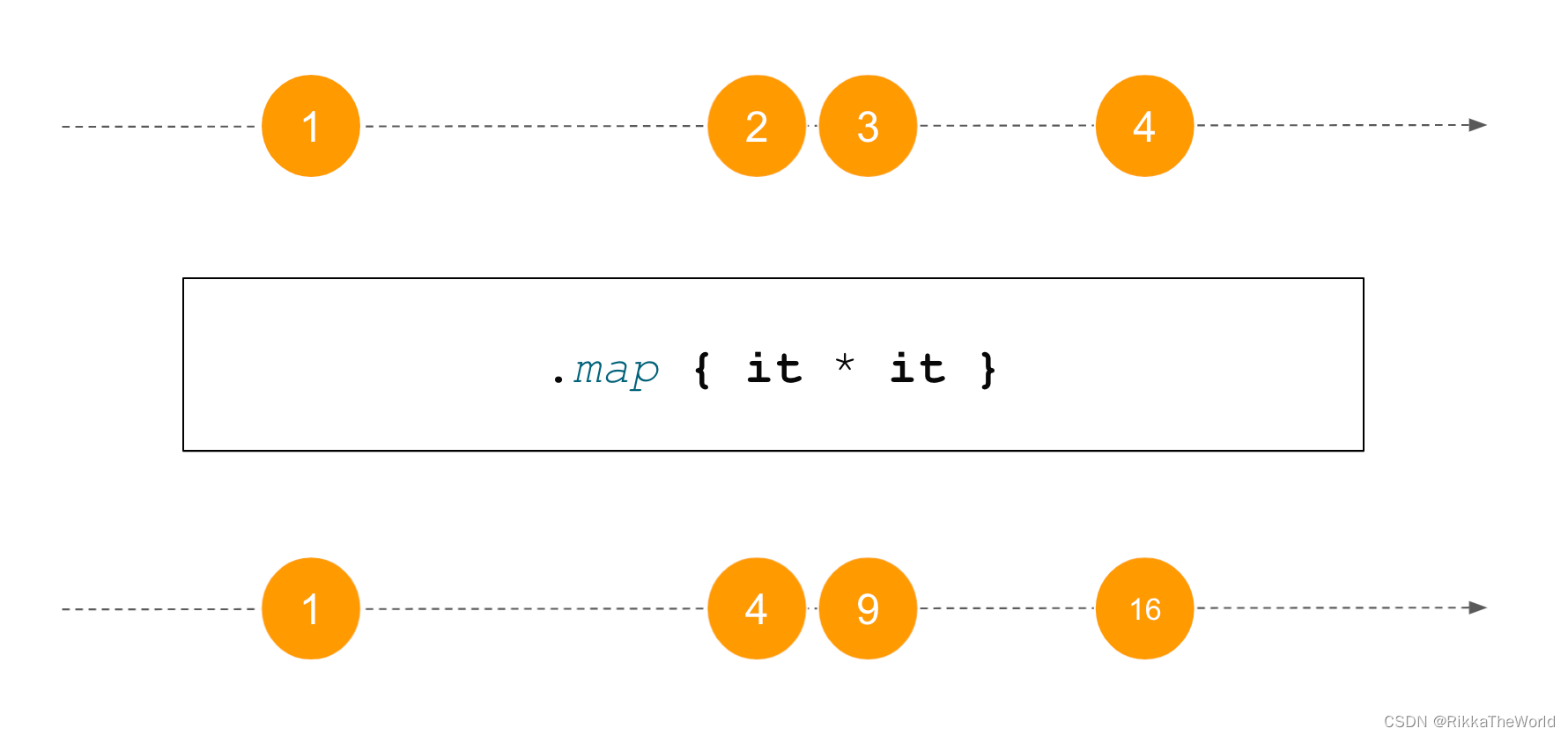
之后,我将使用上面所示的图片来可视化 flow 处理函数如何随时间改变元素。水平线表示时间,这条线上的元素是某个时间点该 flow 中被发射的元素。上面的一行表示操作之前的数据流,下面一行表示操作之后的数据流。这个图还可以用来表示使用多个操作,比如下图中的 map 和 filter。
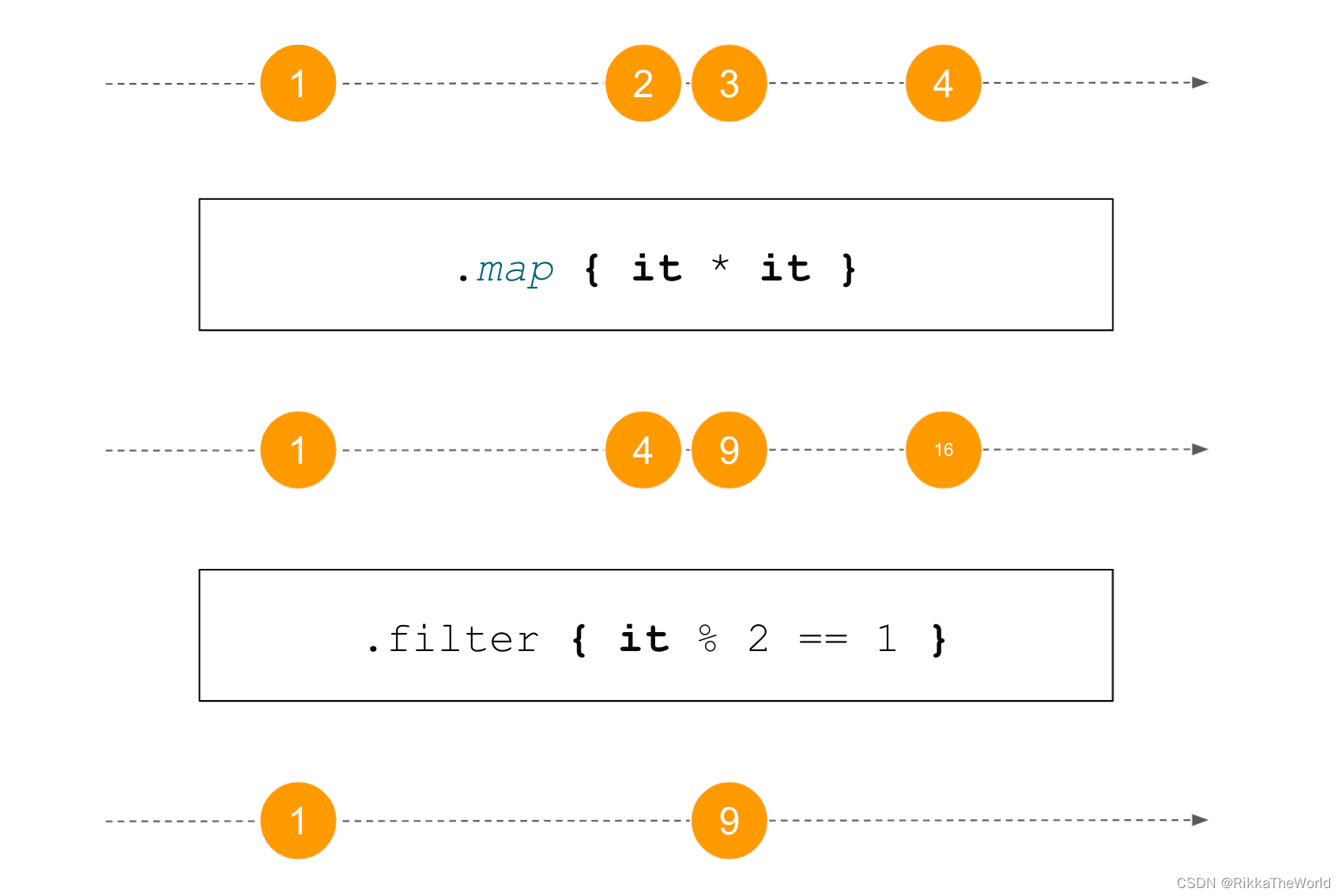
大多数 Flow 处理函数,都很容易通过我们前面章节学习的工具来实现。要实现 map,我们可以使用 flow 构建器来创建一个新的 flow。然后,我们可以从前一个 flow 中收集元素,并发射出经过转换的元素。下面的实现是来自于 kotlin.coroutines 库中 map 的一个简化版本:
fun <T, R> Flow<T>.map(
transform: suspend (value: T) -> R
): Flow<R> = flow {
// 这里我们创建了一个 flow
collect {
value -> // 这里我们从接收者哪里收集数据
emit(transform(value))
}
}
map 是一个非常受欢迎的函数。它的用法有解包或者将值转换成不同的类型。
// 这里我们使用 map 来从输入事件中获得用户操作
fun actionsFlow(): Flow<UserAction> =
observeInputEvents()
.map {
toAction(it.code) }
// 这里我们把 User 转化成 UserJson
fun getAllUser(): Flow<UserJson> =
userRepository.getAllUsers()
.map {
it.toUserJson() }
filter
下一个重要的函数是 filter,它返回一个仅包含原始 flow 中匹配了给定谓词的数据的 flow。
suspend fun main() {
(1..10).asFlow() // [1, 2, 3, 4, 5, 6, 7, 8, 9, 10]
.filter {
it <= 5 } // [1, 2, 3, 4, 5]
.filter {
isEven(it) } // [2, 4]
.collect {
print(it) } // 24
}
fun isEven(num: Int): Boolean = num % 2 == 0
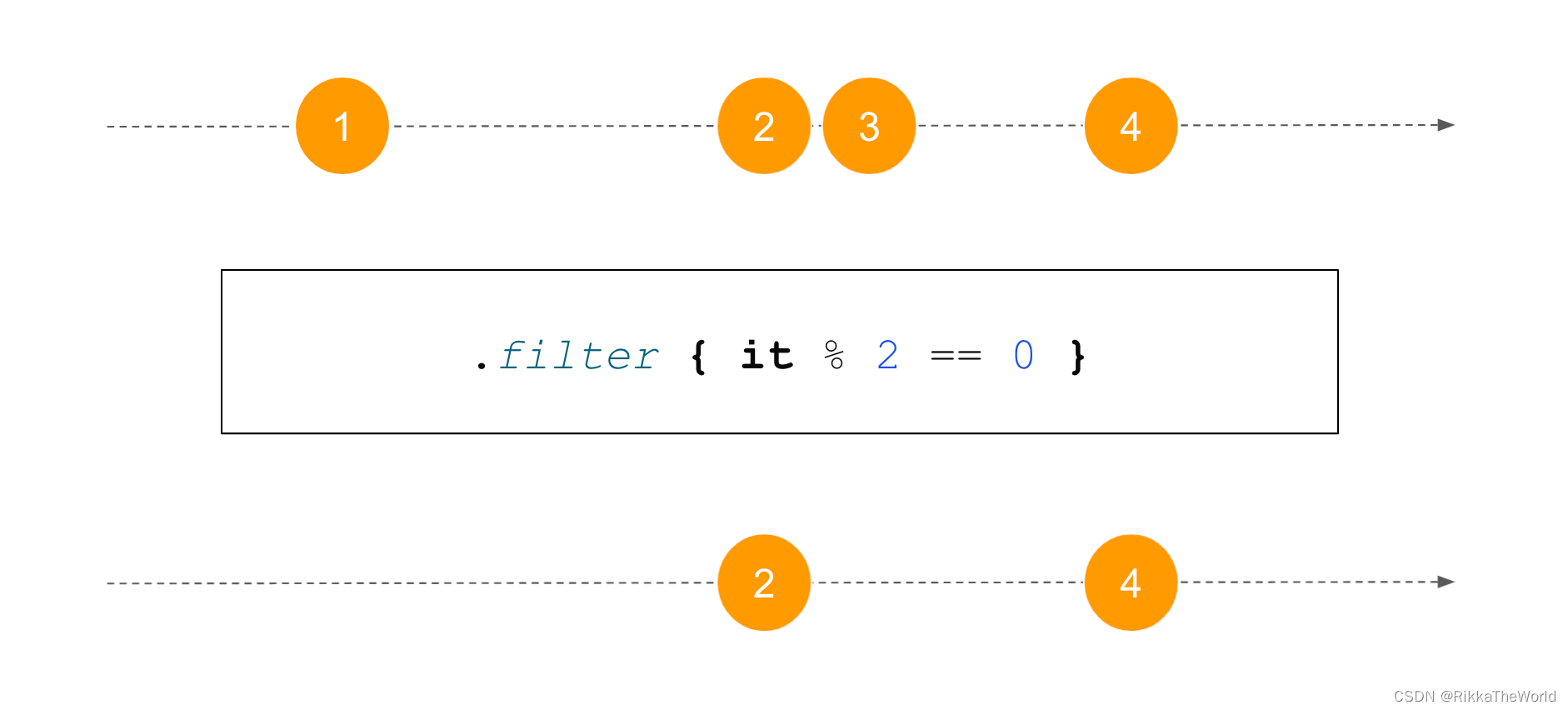
使用 flow 构建器也可以非常容易地实现此函数。我们只需要引入一个 if 语句和谓词(替代了转换)。
fun <T> Flow<T>.filter(
predicate: suspend (T) -> Boolean
): Flow<T> = flow {
// 这里我们创建一个流
collect {
value -> // 这里我们从接收者那里接收元素
if (predicate(value)) {
emit(value)
}
}
}
filter 通常用于排除我们不需要的元素。
// 这里我们使用 filter 去过滤掉我们不想要的元素
fun actionsFlow(): Flow<UserAction> =
observeInputEvents()
.filter {
isValidAction(it.code) }
.map {
toAction(it.code) }
take 和 drop
我们使用 take 来传递一定数量的元素。
suspend fun main() {
('A'..'Z').asFlow()
.take(5) // [A, B, C, D, E]
.collect {
print(it) } // ABCDE
}
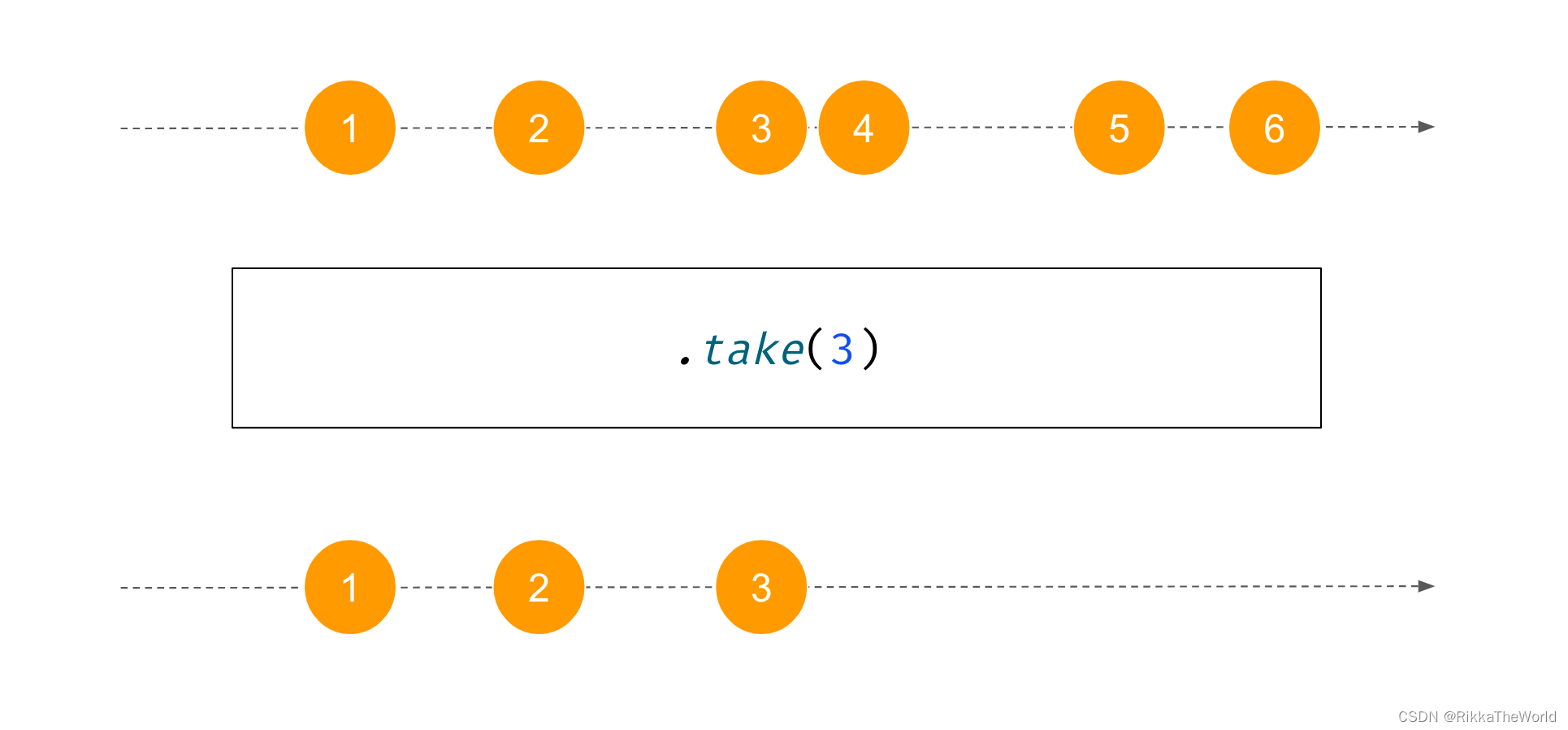
我们使用 drop 来忽略特定数量的元素。
suspend fun main() {
('A'..'Z').asFlow()
.drop(20) // [U, V, W, X, Y, Z]
.collect {
print(it) } // UVWXYZ
}
它们低层是如何工作的?
我们已经看到了相当多的 flow 处理和生命周期函数。它们的实现非常简单,没有什么神奇的东西在里面。大多数这样的函数都可以用 flow 构建器,并用 collect 来实现。下面是一个简单的流处理示例,包括简化的 map 和 flowOf 实现:
suspend fun main() {
flowOf('a', 'b')
.map {
it.uppercase() }
.collect {
print(it) } // AB
}
fun <T, R> Flow<T>.map(
transform: suspend (value: T) -> R
): Flow<R> = flow {
collect {
value ->
emit(transform(value))
}
}
fun <T> flowOf(vararg elements: T): Flow<T> = flow {
for (element in elements) {
emit(element)
}
}
如果内联 flowOf 和 map 函数,你将得到下面代码(我在 lambdas 上添加了标签和带有数字的注释)。
suspend fun main() {
flow [email protected]{
// 1
flow [email protected]{
// 2
for (element in arrayOf('a', 'b')) {
// 3
this@flowOf.emit(element) // 4
}
}.collect {
value -> // 5
this@map.emit(value.uppercase()) // 6
}
}.collect {
// 7
print(it) // 8
}
}
让我们一步一步的分析。
- 我们在注释1处启动一个 flow,并在注释7处调用了其
collect函数 - 当我们启动收集时,我们会调用
@map(注释1)的 lambda 表达式,它在注释2处启动了另一个 flow 构建器,并在注释5处去收集。 - 所以此时,我们我们启动
@flowOn(注释2处)的 lambda 表达式,它迭代了包含 ‘a’ 和 ‘b’ 的数组。 - 第一个值 ‘a’ 在注释4被发射,发射到了注释5处,该 lambda 表达式将值转换成 ‘A’ ,并从 @map 的
collect函数中发射出去,从而调用到 7 处的 lambda 表达式, 该值被打印了出来。 - 注释7结束了,会在注释6处恢复,因为注释6没有别的内容,所以它也结束了,所以我们在注释4处恢复了
@flowOf。 - 我们继续迭代并在注释4处发射 ‘b’ ,因此我们调用注释5处的 lambda 函数,将值 转成成 ‘B’,并从
@map的collect函数中发射出去。该值就会在注释7处被收集,然后在注释8处被打印。 - 接着注释7结束,恢复到注释6处,也完成了。所以我们在注释4处恢复
@flowOf。它也完成了。由于没有更多的内容,我们到达了@map的结尾,这样,我们在注释7恢复,并到达了 main 函数的结尾。
在大多数 flow 处理和生命周期函数中也会是相同的情况,所以理解这一点可以让我们更好的理解 flow 是如何运作的。
merge, zip 和 combine
接下来学习将两个流合并成一个流。有几种方法可以做到这一点。最简单的方法是将两个流中的元素合并成一个。无论 flow 的元素源自哪里,都不用做任何修改,为此,我们可以使用 merge 函数。
suspend fun main() {
val ints: Flow<Int> = flowOf(1, 2, 3)
val doubles: Flow<Double> = flowOf(0.1, 0.2, 0.3)
val together: Flow<Number> = merge(ints, doubles)
print(together.toList())
// [1, 0.1, 0.2, 0.3, 2, 3]
// 或者 [1, 0.1, 0.2, 0.3, 2, 3]
// 或者 [0.1, 1, 2, 3, 0.2, 0.3]
// 或者其他的组合
}
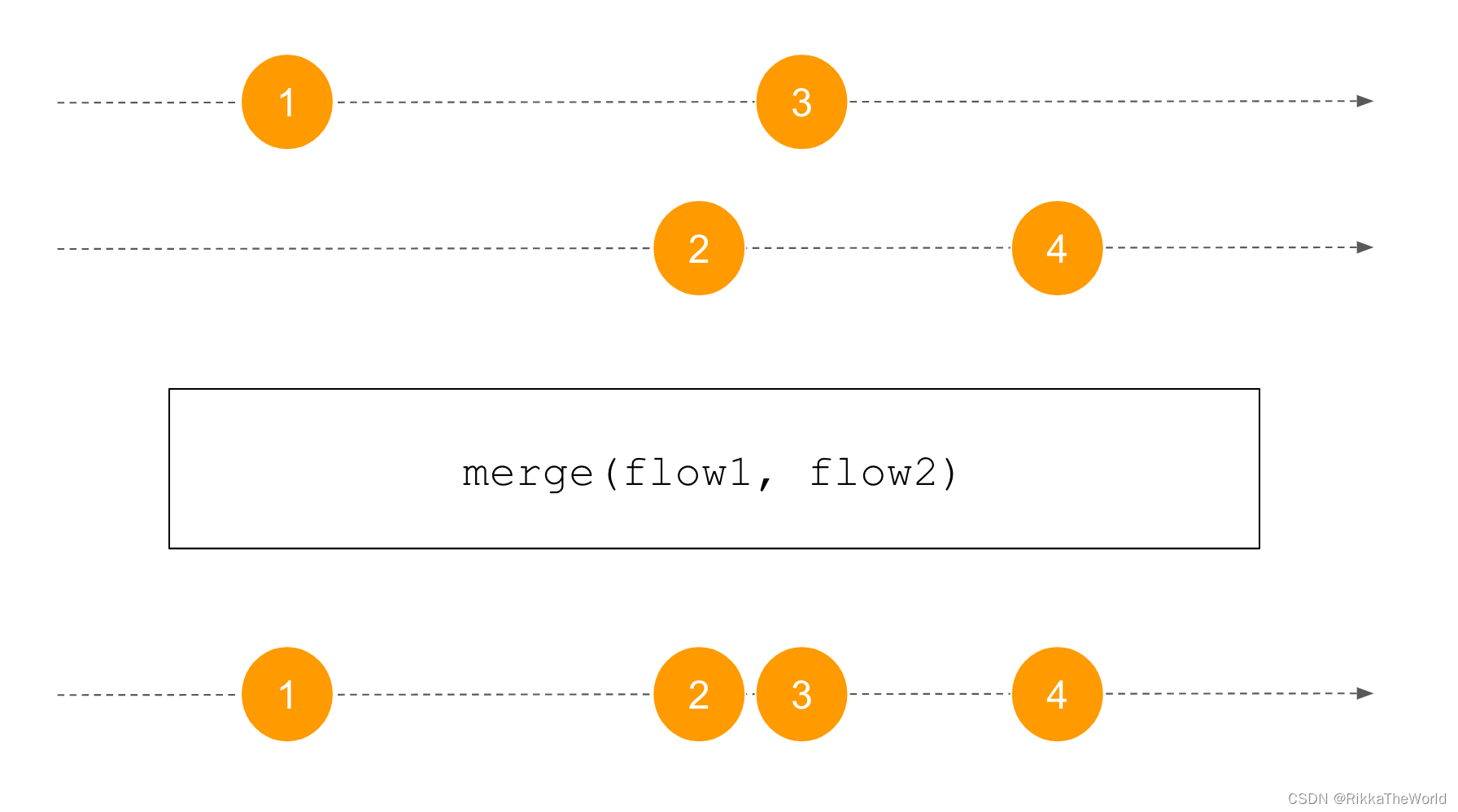
重要的点是,当我们使用 merge 时,一个流的元素不需要等待另一个流上的元素。例如,在下面的例子中,来自第一个 flow 的元素被延迟,但这并不会影响来自第二个 flow 的元素。
suspend fun main() {
val ints: Flow<Int> = flowOf(1, 2, 3)
.onEach {
delay(1000) }
val doubles: Flow<Double> = flowOf(0.1, 0.2, 0.3)
val together: Flow<Number> = merge(ints, doubles)
together.collect {
println(it) }
}
// 0.1
// 0.2
// 0.3
// (1 sec)
// 1
// (1 sec)
// 2
// (1 sec)
// 3
当有多个事件源都有相同的操作时,我们可以使用 merge。
fun listenForMessages() {
merge(userSentMessages, messagesNotifications)
.onEach {
displayMessage(it) }
.launchIn(scope)
}
下一个函数是 zip,它对两个 flow 进行配对。我们需要定义一个函数来决定元素是如何配对的(配对后结果将在发射到新的 flow 中)。每个元素只能是一对一的配对,所以它需要等待和它配对的那一个。没有配对的元素将会丢失,因此,当一个 flow 的压缩完成时,新的 flow 也将完成(其它 flow 亦是如此)。
suspend fun main() {
val flow1 = flowOf("A", "B", "C")
.onEach {
delay(400) }
val flow2 = flowOf(1, 2, 3, 4)
.onEach {
delay(1000) }
flow1.zip(flow2) {
f1, f2 -> "${
f1}_${
f2}" }
.collect {
println(it) }
}
// (1 sec)
// A_1
// (1 sec)
// B_2
// (1 sec)
// C_3
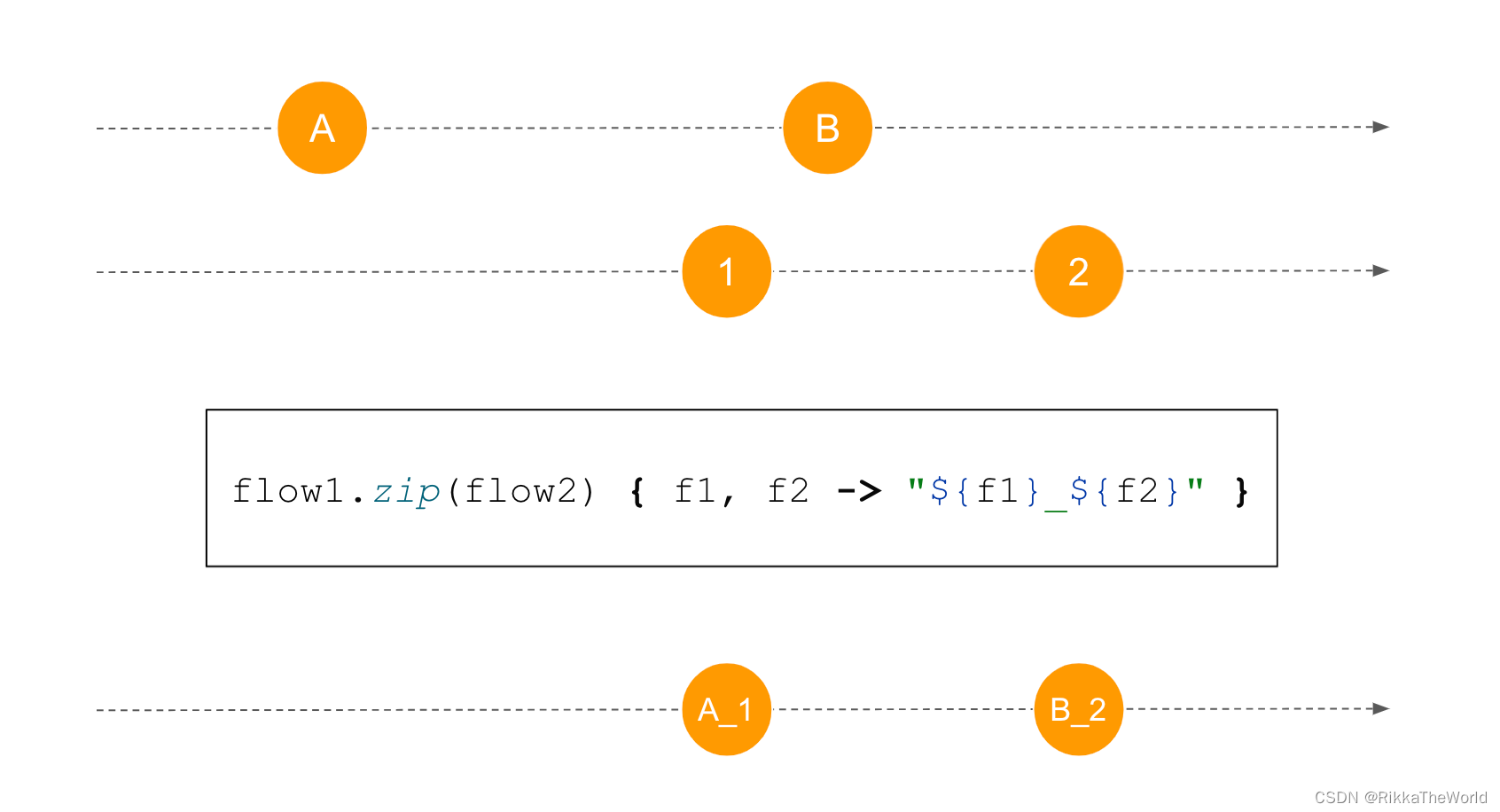
zip 函数让我想起了波兰的传统舞蹈 —— 波罗涅滋舞。这种舞蹈的一个特点是,一排成对的人从中间分开,然后他们再次相遇后会重新组合。

组合两个 flow 的最后一个重要函数是 combine。就像 zip 一样,它也是从元素中形成对,快的 flow 生成的元素必须等待较慢的那个 flow 生成的元素来产生第一对。然而,与波兰舞的相似之处到此为止。使用 combine 时,每个新元素都会替换它的前一个元素。如果第一对已经形成,一个新的元素将和来自另一个 flow 的前一个元素一起产生新的对。
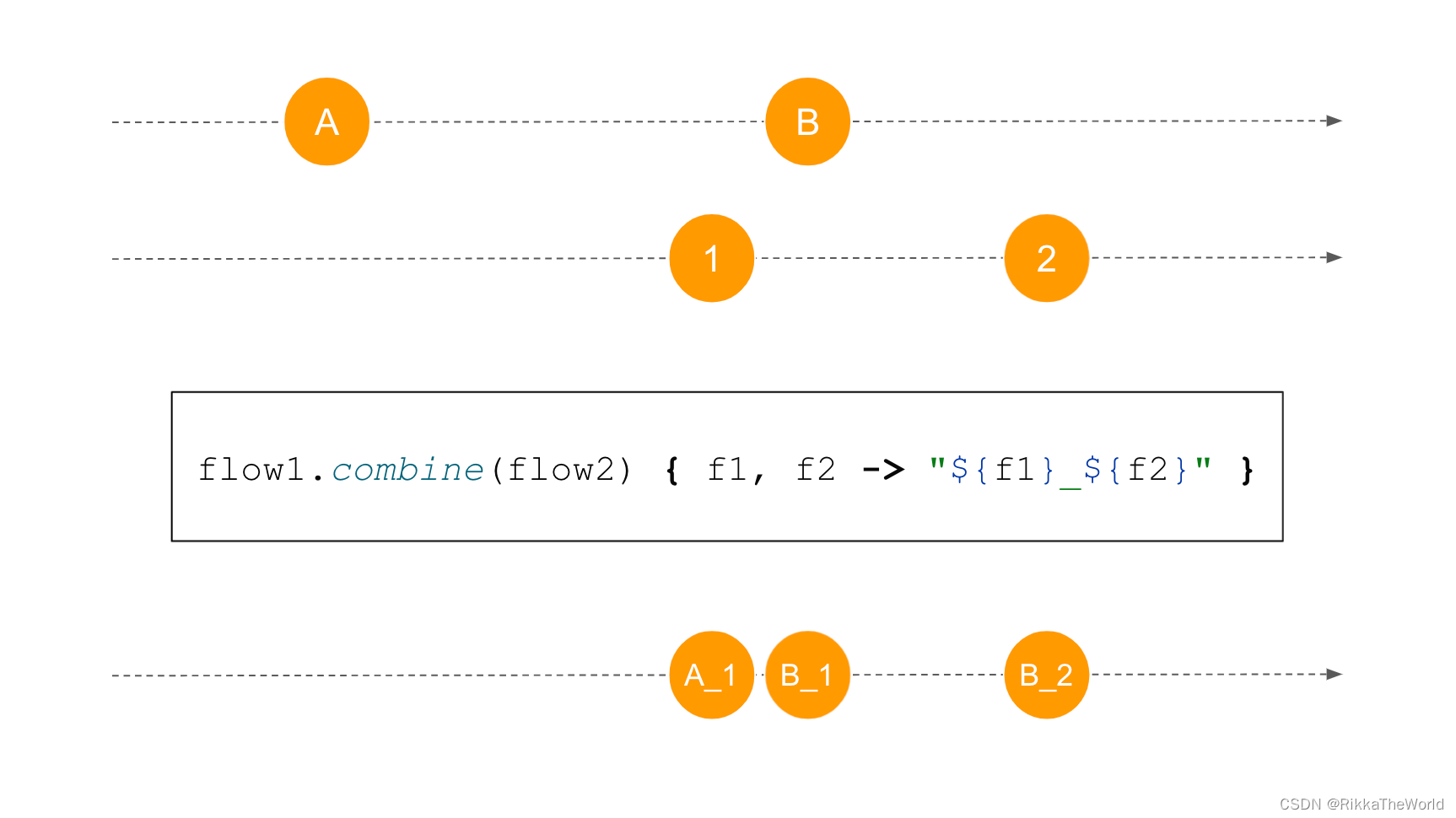
注意, zip 需要配对,所以当第一个 flow 关闭时,zip 就关闭了。 而 combine 没有这样的限制,直到两个 flow 都关闭前,它将一直发射数据。
suspend fun main() {
val flow1 = flowOf("A", "B", "C")
.onEach {
delay(400) }
val flow2 = flowOf(1, 2, 3, 4)
.onEach {
delay(1000) }
flow1.combine(flow2) {
f1, f2 -> "${
f1}_${
f2}" }
.collect {
println(it) }
}
// (1 sec)
// B_1
// (0.2 sec)
// C_1
// (0.8 sec)
// C_2
// (1 sec)
// C_3
// (1 sec)
// C_4
当我们需要观察两个来源的变化时,通常会使用 combine。我们还可以向每个组合的 flow 添加初始值(以获得初始对)。
userUpdateFlow.onStart {
emit(currentUser) }
一个典型的场景是当一个视图有两个数据源。例如,当一个通知同时依赖用户的当前状态和一些通知时,我们可以同时观察它们并结合它们的更改来更新视图。
userStateFlow
.combine(notificationsFlow) {
userState, notifications ->
updateNotificationBadge(userState, notifications)
}
.collect()
fold 和 scan
如果你使用过集合处理函数,你可能会了解 fold(折叠)。通过对每个元素(从初始值开始)应用将两个值合并为一个值的操作,将集合中的所有值合并成一个。
例如,如果初始值是0,操作是加法,那么结果是所有数字的和:我们首先取初始值0,然后,我们把第一个元素1加上去;在结果1上,我们加上第二个数字2;对结果3,我们加上第三个数字3;对结果6,我们加上最后一个数字4,这个操作的结果是10,也就是 fold 返回的结果。
fun main() {
val list = listOf(1, 2, 3, 4)
val res = list.fold(0) {
acc, i -> acc + i }
println(res) // 10
val res2 = list.fold(1) {
acc, i -> acc * i }
println(res2) // 24
}
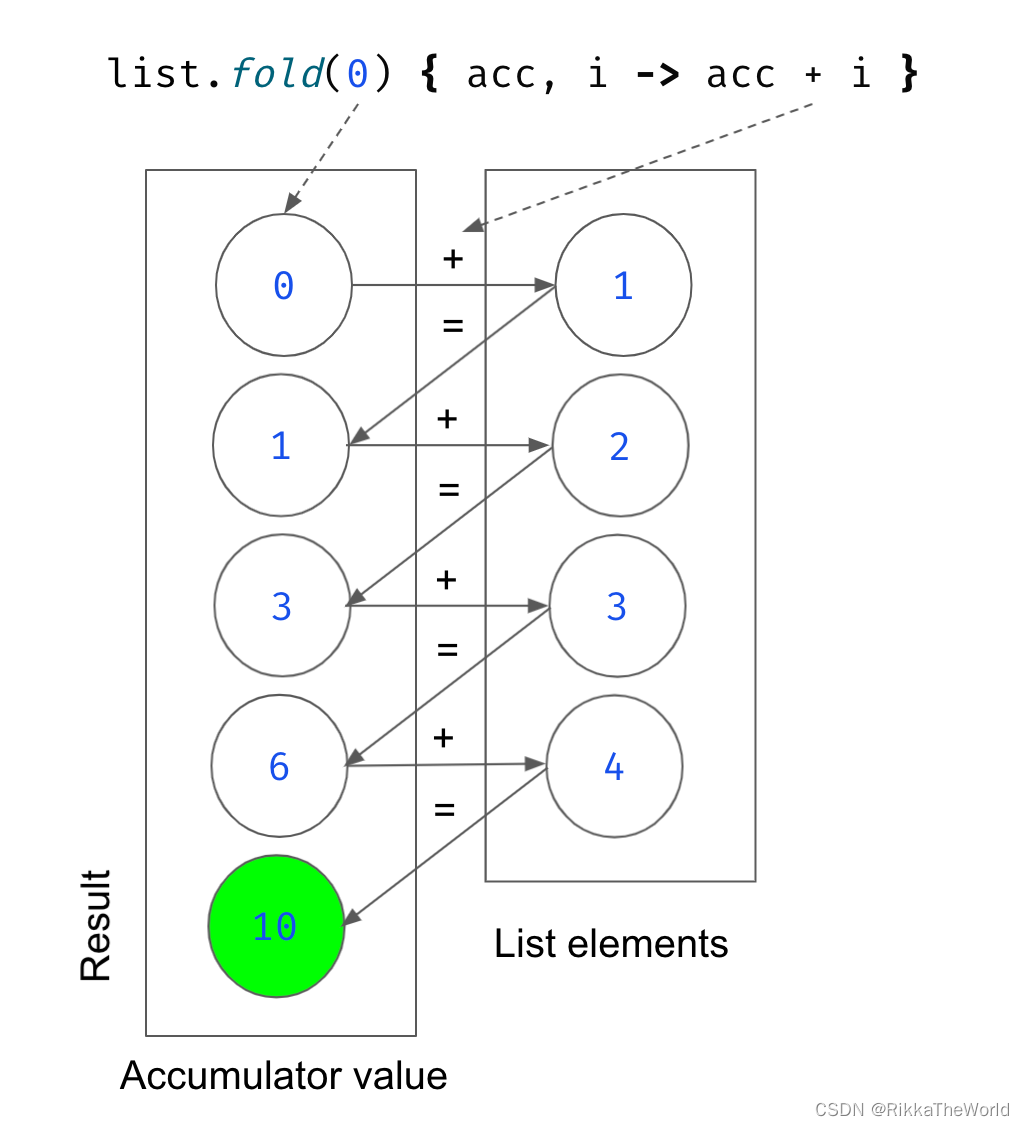
fold 是一个终端操作,它也可以用于flow,但是它会挂起直到 flow 完成(就像 collect)一样。
suspend fun main() {
val list = flowOf(1, 2, 3, 4)
.onEach {
delay(1000) }
val res = list.fold(0) {
acc, i -> acc + i }
println(res)
}
// (4 sec)
// 10
有一种替代 fold 函数是 scan。它是一个能产生所有中间值的中间操作:
fun main() {
val list = listOf(1, 2, 3, 4)
val res = list.scan(0) {
acc, i -> acc + i }
println(res) // [0, 1, 3, 6, 10]
}
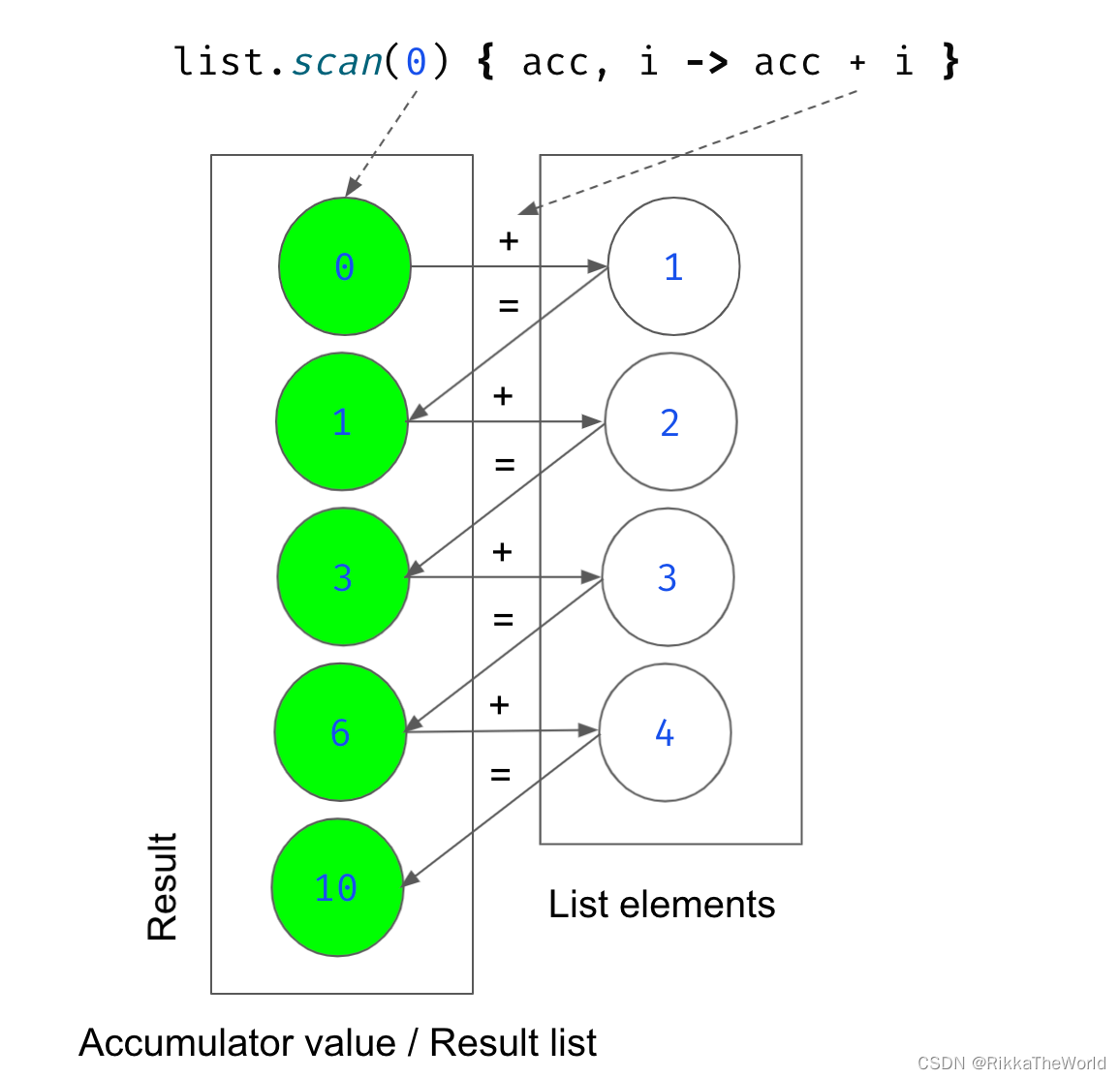
scan 对于 flow 来说非常有用,因为它可以在接收到上一步产生的值后,立即产生一个新的值。
suspend fun main() {
flowOf(1, 2, 3, 4)
.onEach {
delay(1000) }
.scan(0) {
acc, v -> acc + v }
.collect {
println(it) }
}
// 0
// (1 sec)
// 1
// (1 sec)
// 3
// (1 sec)
// 6
// (1 sec)
// 10
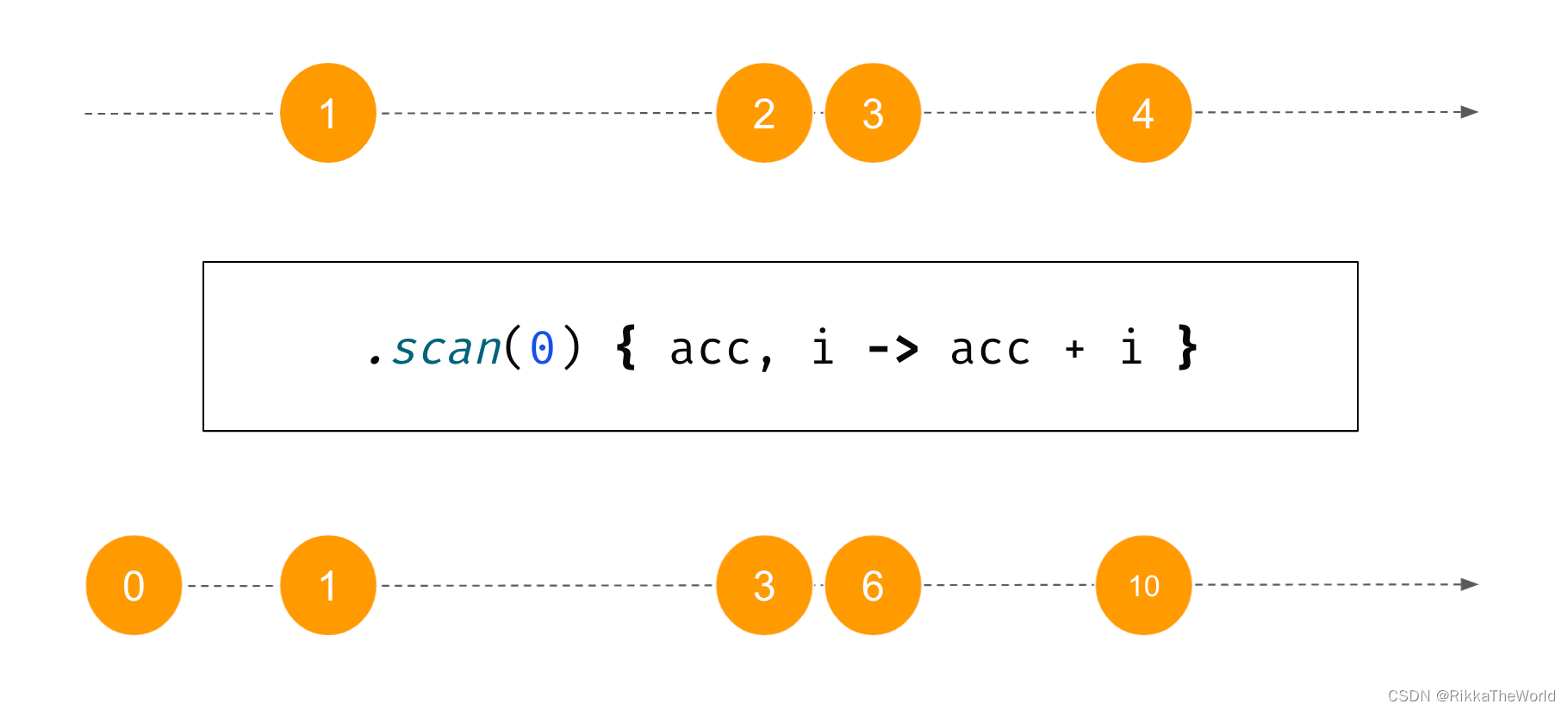
我们可以使用 flow 构建器和 collect 轻松实现 scan。我们首先发射出初始值,然后对每个新元素发出下一个值的累积结果。
fun <T, R> Flow<T>.scan(
initial: R,
operation: suspend (accumulator: R, value: T) -> R
): Flow<R> = flow {
var accumulator: R = initial
emit(accumulator)
collect {
value ->
accumulator = operation(accumulator, value)
emit(accumulator)
}
}
scan 典型的使用场景是当我们需要更新或更改 flow ,或我们需要一个对象,这个对象是这些改变的结果时。
val userStateFlow: Flow<User> = userChangesFlow
.scan(user) {
acc, change -> user.withChange(change) }
val messagesListFlow: Flow<List<Message>> = messagesFlow
.scan(messages) {
acc, message -> acc + message }
flatMapConcat, flatMapMerge 和 flatMapLatest
另一个著名的集合处理函数是 flatMap,它类似于 map,但是这个转换函数最终返回一个扁平化的集合。例如,你有一个部门列表,每个部门都有一个员工列表,那么你可以使用 flatMap 来列出所有部门的所有员工。
val allEmployees: List<Employee> = departments
.flatMap {
department -> department.employees }
val listOfListsOfEmployee: List<List<Employee>> = departments
.map {
department -> department.employees }
flatMap 是如何应用到 flow 上的呢?我们可以期望可以返回一个 flow,然后该 flow 应该是扁平化的。问题是流动的元素可以随时间扩散,那么,一个流上的元素是否应该等待另外一个流上的元素,还是应该同时处理它们?因为没有一个明确的答案,所以 Flow 没有 flatMap 函数,而是有 flatMapConcat、 flatMapMerge 和 flatMapLatest。
flatMapConcat 函数依次处理生成的 flow。因此,第二个 flow 可以在第一个 flow 完成时启动。在下面的例子中,我们使用字符 “A” “B” “C” 来创建一个 flow,它们产生的新 flow 会包括这些字符和数字,中间有1s的延迟。
fun flowFrom(elem: String) = flowOf(1, 2, 3)
.onEach {
delay(1000) }
.map {
"${
it}_${
elem} " }
suspend fun main() {
flowOf("A", "B", "C")
.flatMapConcat {
flowFrom(it) }
.collect {
println(it) }
}
// (1 sec)
// 1_A
// (1 sec)
// 2_A
// (1 sec)
// 3_A
// (1 sec)
// 1_B
// (1 sec)
// 2_B
// (1 sec)
// 3_B
// (1 sec)
// 1_C
// (1 sec)
// 2_C
// (1 sec)
// 3_C
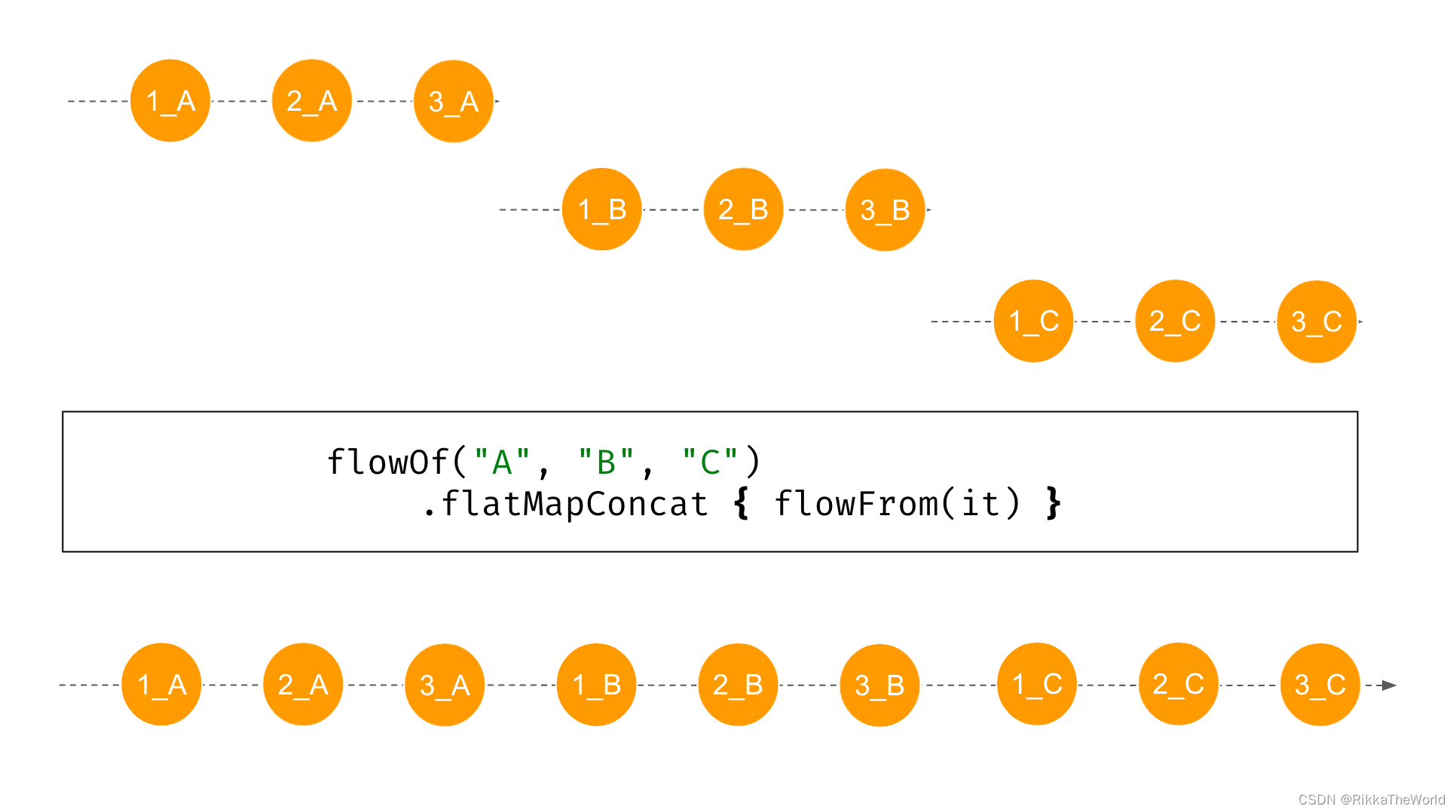
第二个函数 flatMapMerge 对我来说是最直观的,它同时处理 flow 生成的值。
fun flowFrom(elem: String) = flowOf(1, 2, 3)
.onEach {
delay(1000) }
.map {
"${
it}_${
elem} " }
suspend fun main() {
flowOf("A", "B", "C")
.flatMapMerge {
flowFrom(it) }
.collect {
println(it) }
}
// (1 sec)
// 1_A
// 1_B
// 1_C
// (1 sec)
// 2_A
// 2_B
// 2_C
// (1 sec)
// 3_A
// 3_B
// 3_C

可以使用 concurrently 参数来设置处理 flow 的并发数量。这个参数的默认值是16,但是可以在 JVM 属性的 DEFAULT_CONCURRENCY_PROPERTY_NAME 去更改它。注意这个默认限制,因为如果你在包含许多元素的 flow 上使用 flatMapMerge 时,同时只会同时处理16个元素。
suspend fun main() {
flowOf("A", "B", "C")
.flatMapMerge(concurrency = 2) {
flowFrom(it) }
.collect {
println(it) }
}
// (1 sec)
// 1_A
// 1_B
// (1 sec)
// 2_A
// 2_B
// (1 sec)
// 3_A
// 3_B
// (1 sec)
// 1_C
// (1 sec)
// 2_C
// (1 sec)
// 3_C
flatMapMerge 的典型使用场景是当我们需要为 flow 中的每个元素请求数据时。例如,我们有一个类别列表,你需要为每个类别请求报价。你已经知道可以通过 async 函数来实现这一点。而使用 flatMapMerge 流有两个优点:
- 我们可以控制并发参数,来决定我们想在同一时间取多少类别(以避免同时发送数百个请求)
- 我们可以返回
Flow并在下一个元素到达时发送它们(所以,在功能使用端,这些值可以被立即处理)
suspend fun getOffers(
categories: List<Category>
): List<Offer> = coroutineScope {
categories
.map {
async {
api.requestOffers(it) } }
.flatMap {
it.await() }
}
// 更好的解决方案
suspend fun getOffers(
categories: List<Category>
): Flow<Offer> = categories
.asFlow()
.flatMapMerge(concurrency = 20) {
suspend {
api.requestOffers(it) }.asFlow()
// 或者 flow { emit(api.requestOffers(it)) }
}
最后一个函数是 flatMapLatest。一旦新的 flow 出现,它就会遗忘之前的 flow。对于每个新的值,之前的流处理将会被遗忘。因此,如果 “A”、“B”、“C”之间没有延迟,那么你只会看到 “1_C”,“2_C”、“3_C”。
fun flowFrom(elem: String) = flowOf(1, 2, 3)
.onEach {
delay(1000) }
.map {
"${
it}_${
elem} " }
suspend fun main() {
flowOf("A", "B", "C")
.flatMapLatest {
flowFrom(it) }
.collect {
println(it) }
}
// (1 sec)
// 1_C
// (1 sec)
// 2_C
// (1 sec)
// 3_C
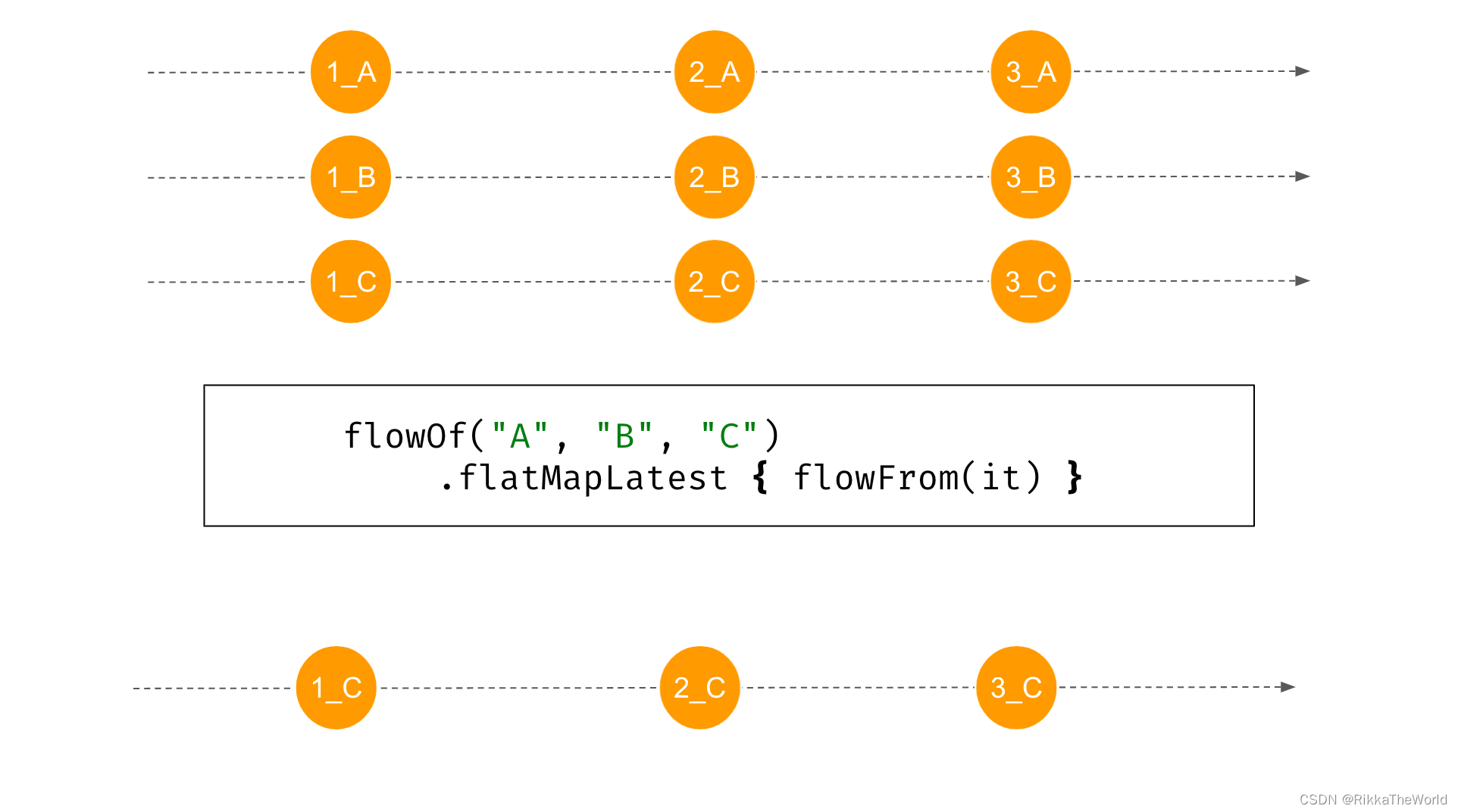
当初始 flow 中的元素有延迟时,事情就变的有趣了起来。下面的例子中,(1.2s后)“A”启动了它的 flow,也就是 flowFrom 。该 flow 在1s内产生了一个元素“1_A”,但是1200ms后出现了“B”,之前的 flow 被关闭并被遗忘。当“C”出现并启动了新的 flow 时,“B” 成功的产生了“1_B”。这个函数最终将生成元素“1_C”、“2_C”、“3_C”,中间有1s的延迟。
suspend fun main() {
flowOf("A", "B", "C")
.onEach {
delay(1200) }
.flatMapLatest {
flowFrom(it) }
.collect {
println(it) }
}
// (2.2 sec)
// 1_A
// (1.2 sec)
// 1_B
// (1.2 sec)
// 1_C
// (1 sec)
// 2_C
// (1 sec)
// 3_C
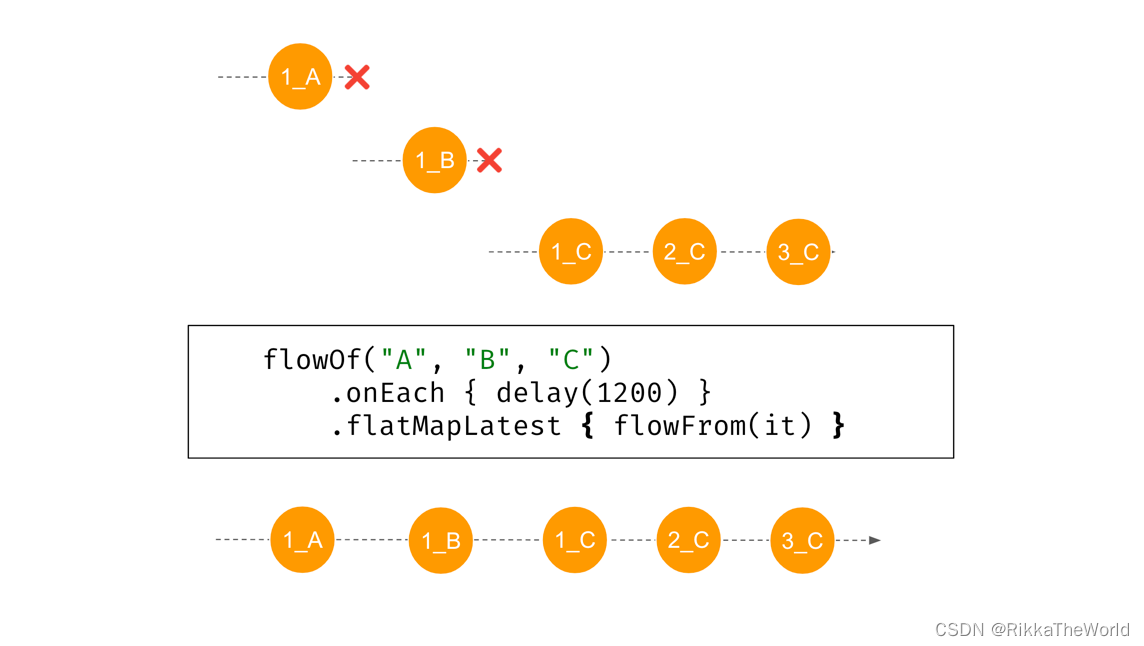
终端操作
最后,我们有结束 flow 处理的操作。这些被称为终端操作。到目前为止,我们只使用了 collect。但还有其他类似于集合和序列提供的方法:count(计算 flow 中元素的数量)、first 和 firstOrNull(获取 flow 中发射出的第一个元素)、fold 和 reduce(将元素积累到一个对象中)。终端操作将被挂起,并在 flow 完成时返回值。
suspend fun main() {
val flow = flowOf(1, 2, 3, 4) // [1, 2, 3, 4]
.map {
it * it } // [1, 4, 9, 16]
println(flow.first()) // 1
println(flow.count()) // 4
println(flow.reduce {
acc, value -> acc * value }) // 576
println(flow.fold(0) {
acc, value -> acc + value }) // 30
}
目前, flow 的终端操作虽然不多,但如果你需要一些不同的操作,你总是可以自己实现它。例如下面实现整型流的 sum:
suspend fun Flow<Int>.sum(): Int {
var sum = 0
collect {
value ->
sum += value
}
return sum
}
类似地,仅适用 collect 方法就可以实现几乎任何终端操作。
总结
有许多工具支持 flow 处理。对它们有所了解是一件好事,因为它们在后端和 Android 开发中都很有用。另外,如果你需要一些不同的函数,可以通过 collect 方法和 flow 构建器轻松的实现它们。
边栏推荐
- Install sqlserver2019
- [programming questions] [scratch Level 2] March 2019 garbage classification
- 一鍵免費翻譯300多頁的pdf文檔
- Ping error: unknown name or service
- 手写一个模拟的ReentrantLock
- Stm32f1 and stm32cubeide programming example - rotary encoder drive
- 在网页中打开展示pdf文件
- Single machine high concurrency model design
- Anaconda+pycharm+pyqt5 configuration problem: pyuic5 cannot be found exe
- The difference between get and post
猜你喜欢
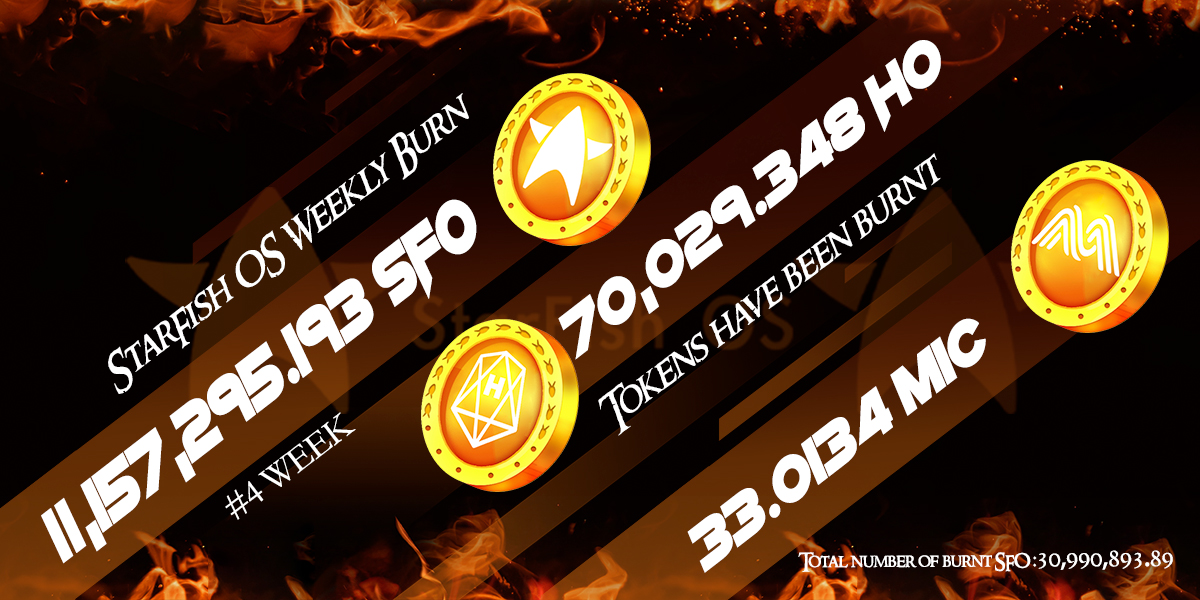
第四期SFO销毁,Starfish OS如何对SFO价值赋能?

How does starfish OS enable the value of SFO in the fourth phase of SFO destruction?
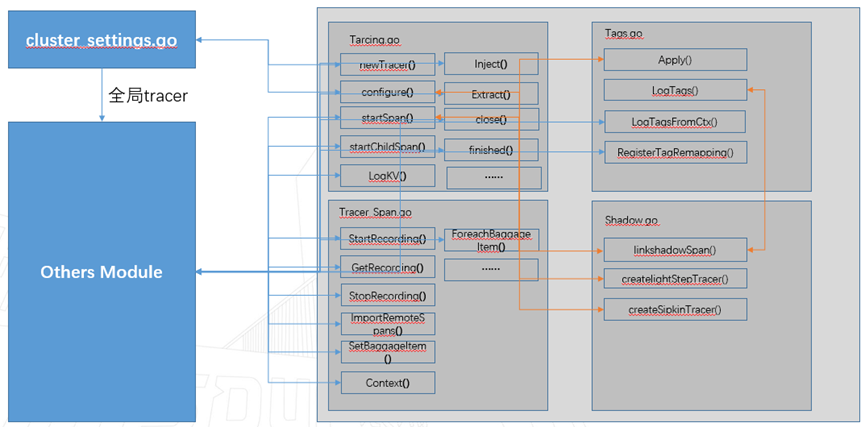
浪潮云溪分布式数据库 Tracing(二)—— 源码解析

Coindesk comments on the decentralization process of the wave field: let people see the future of the Internet
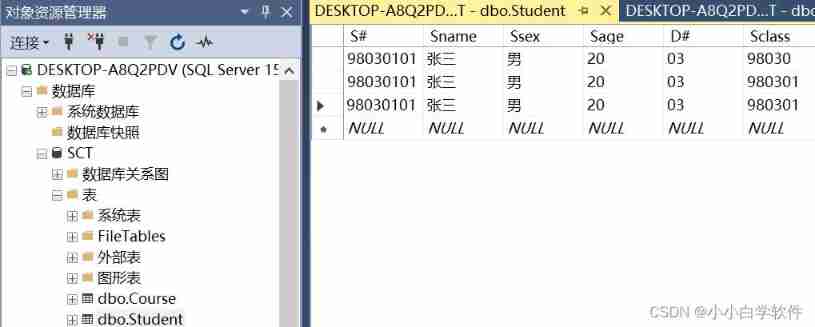
Basic learning of SQL Server -- creating databases and tables with code
PostGIS learning
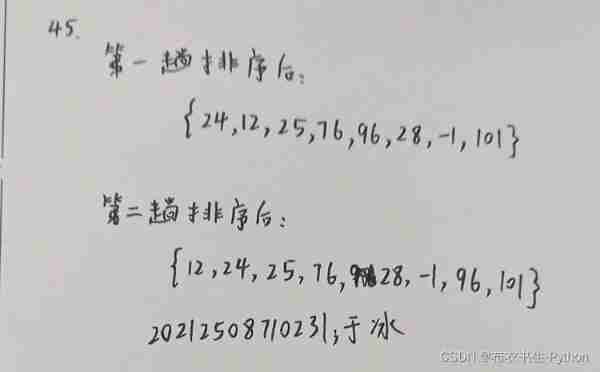
C language 005: common examples
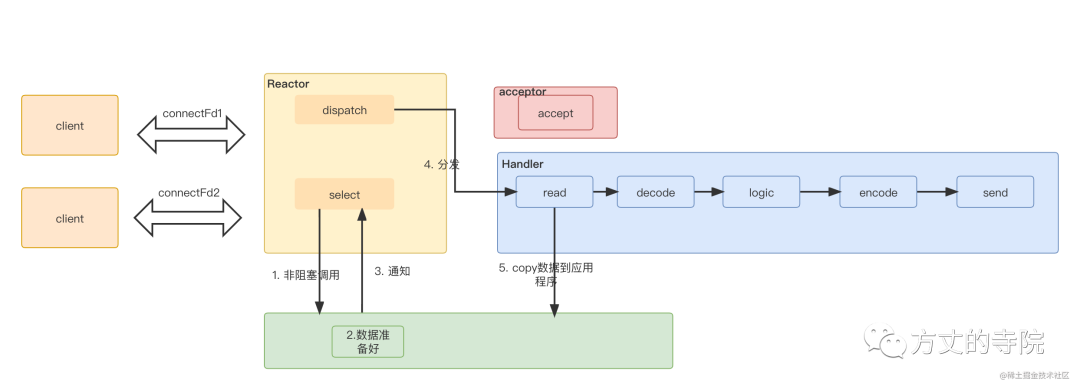
单机高并发模型设计

Notice on organizing the second round of the Southwest Division (Sichuan) of the 2021-2022 National Youth electronic information intelligent innovation competition
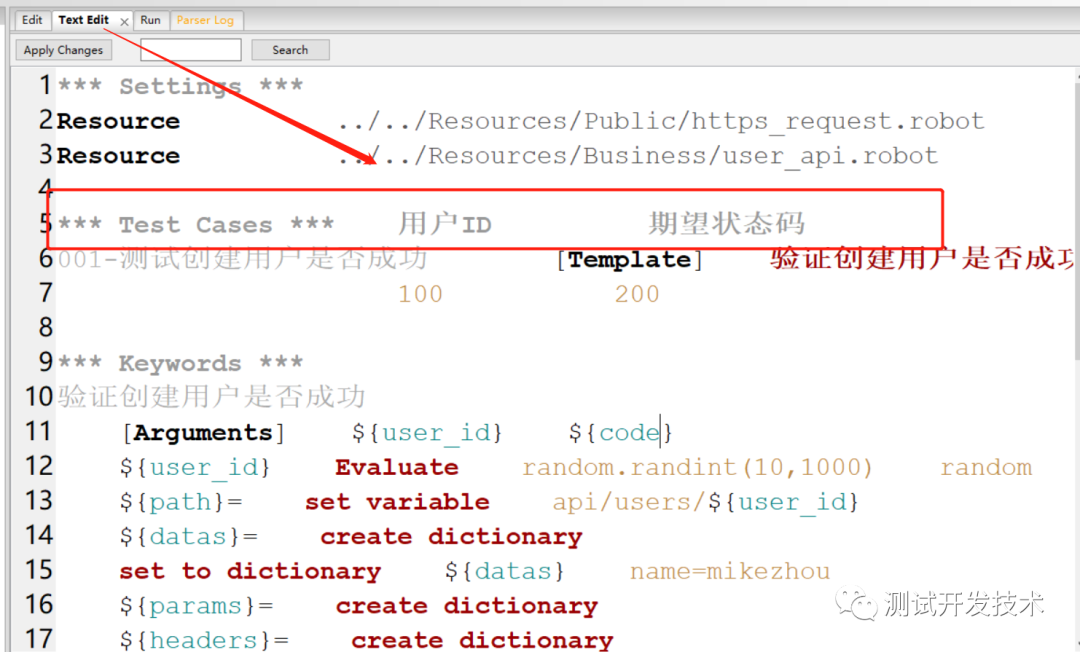
Automated testing: robot framework is a practical skill that 90% of people want to know
随机推荐
paddle入门-使用LeNet在MNIST实现图像分类方法一
【编程题】【Scratch二级】2019.09 制作蝙蝠冲关游戏
How can CSDN indent the first line of a paragraph by 2 characters?
Go learning notes (1) environment installation and hello world
第四期SFO销毁,Starfish OS如何对SFO价值赋能?
一鍵免費翻譯300多頁的pdf文檔
[研发人员必备]paddle 如何制作自己的数据集,并显示。
Usage of limit and offset (Reprint)
Prompt configure: error: required tool not found: libtool solution when configuring and installing crosstool ng tool
ROS从入门到精通(九) 可视化仿真初体验之TurtleBot3
Go learning notes (2) basic types and statements (1)
Coindesk comments on the decentralization process of the wave field: let people see the future of the Internet
大数据开源项目,一站式全自动化全生命周期运维管家ChengYing(承影)走向何方?
Redis caching tool class, worth owning~
【编程题】【Scratch二级】2019.03 绘制方形螺旋
paddle入门-使用LeNet在MNIST实现图像分类方法二
用語雀寫文章了,功能真心强大!
At the age of 35, I made a decision to face unemployment
[path planning] use the vertical distance limit method and Bessel to optimize the path of a star
Pigsty: out of the box database distribution
